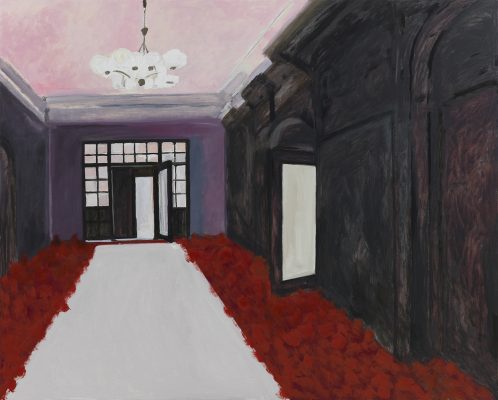In the summer of 2015, when thousands of children were arriving in the United States every month from Honduras, El Salvador, and Guatemala, the Mexican writer Valeria Luiselli volunteered as a court interpreter in New York, where she has lived for several years. Working with non-profit organisation The Door, Luiselli interviewed applicants for asylum, recording the details of their passage through Mexico atop the network of freight trains known as ‘La Bestia’. The resulting essay, modelled on the intake questionnaire given to detainees – ‘Why did you come to the United States?’ – became a reflection on Luiselli’s own immigration process, as well as an attempt to redefine a ‘border crisis’ as a humanitarian one.
It was a powerful account of both bureaucratic neglect and collective guilt, but it also left Luiselli, then the author of two slim novels and a collection of essays, with a difficult question of her own. As an essayist, she found that the children’s stories resisted any tidy narrative order; the resulting book’s title, Tell Me How It Ends, came from a question frequently posed by her daughter, yet always left unanswered. Was there a different way to approach the same subject as a writer of fiction? ‘If I did not write this particular story,’ she explains here, ‘it would not have made sense to return to writing anything else.’ Nearly half a decade later, when the refugee crisis has not only worsened, but sunk to a level of cruelty previously unimaginable, Luiselli’s newest novel is a timely call to revive the socially conscious novel as a viable, morally urgent form, while also avoiding the pitfalls of its predecessors.
Lost Children Archive is loosely based on a road trip Luiselli took with her family in 2014. Two oral historians travel through the American Southwest with their children, visiting the parts of the country that were ‘once Mexico’, as the mother explains, and coming across the deportation of several children from an airfield in Roswell, Texas. As in Tell Me How It Ends, the narrator translates for a woman, Manuela, whose two daughters have been detained at the border, their mother’s phone number sewn into their dresses. A novel-within-the-novel depicts the journey of seven child migrants to the United States, based partly, it seems, on interviews Luiselli conducted. It’s a road-trip narrative, but also an anti-road trip one, countering the horizontal, East-West trajectory of manifest destiny with the vertical migration from the Global South to the richer, industrialised North.
This is a novel supremely aware of its limitations, even hesitant of blending fact and fiction. In one of their first stops, the family wanders into a bookstore where the customers accuse an author of presenting ‘truth-telling as a commodity’ and representing the ‘impossibility of fiction in the age of non-fiction’. These same concerns are reflected in the central couple, who had worked together in New York, documenting each of the city’s eight hundred languages for a project at Columbia University, but who come from radically different backgrounds: the husband is more of a ‘documentarian’, the wife a ‘documentarist’, ‘which meant that I was more like a chemist and he was more like a librarian.’ (None of the family members are named). He wants to embark on a Lanzmann-ian soundscape of the nineteenth-century Chiricahua Apaches, capturing the rustle of wind in their cemeteries, the cries of birds overhead. She plans to return to journalism and work on a documentary about the ‘lost children’ stranded at the border.
The trip will likely be the last time the family is together for several years, the slow unraveling of their marriage a symbol for Luiselli’s own ethical crisis: how to represent people who have been erased from view or made to be ‘undocumented’, present only in history books written by their evictors, or in reports and statistics compiled by their jailers. Relying on this sort of record risks reenacting the violence inflicted on its subjects, but avoiding it risks obscuring them altogether.
The answer comes, in part, by making an archive-novel. ‘My work was simply full of patchwork solutions,’ Luiselli writes, ‘like those old houses where everything is falling apart and you just have to solve things, urgently, no time for turning questions and their possible answers into aesthetic theories.’ Luiselli takes the mantle of ‘documentary fiction’ to a new level, incorporating not only polaroid photographs taken by her family and ‘migrant mortality reports’ issued by the border patrol, in an echo of Roberto Bolaño’s 2666, but also descriptions of sound recordings, loose notes, reading lists, and newspaper clippings. The book is segmented into short chapters, their enigmatic headings recurring throughout: ‘MAPS,’ ‘CLIMAX,’ ‘NARRATIVE ARC’.
The infrastructure of Luiselli’s writing is always significant. Sidewalks, her collection of essays, introduced a touchstone of her writing, in which formal elements take on the task of narrative progression. One essay, about Mexico City, heads each section with the name of its drained lakes; another records her trajectory through the city with the road signs adorning her path. In Lost Children Archive, the seven boxes the family packs in their truck – four for the husband, one for the narrator, one for each child – enter into the narrative, spilling out their contents and laying bare the compositional technique of the novel. We find that the novel-within-the-novel, a slim, red volume called Elegies for Lost Children, is drawn from books in the father’s collection; the archival theories, from a reading list tucked in the mother’s. If good writers borrow, and great writers steal, a writer who provides an annotated syllabus can only be described as honest; by divulging the source material for her novel, Luiselli foregrounds the limits to her own understanding, revealing a writer struggling to piece together a kaleidoscopic vision of an intangible narrative.
The other, more treacherous solution comes from filling in the gaps in the record. Here, Luiselli relies on the ‘cultural translation’ implicit in fiction, its ability to create and inhabit perspectives unavailable to the observer. ‘I am still not sure how I’ll do it,’ says her narrator, ‘but the story I need to tell is the one of the children who are missing, those whose voices can no longer be heard because they are, possibly forever, lost.’ If Tell Me How It Ends circled around the experiences of the children who had arrived, Lost Children Archive will follow them on their journey northward: the quiet nights on the freight train, the long trek in the desert.
This method is fraught with its own problems, magnified by an increasing scepticism toward omniscient, universalising fiction – does anyone have the right to speak for the migrants? – but it’s through both this awareness of distance, and her need to bear witness, that Luiselli reinvents a method for her form. By reshaping the novel according to her own thoughtful perspectives on translation theory, she concedes that many of these stories are not hers, but have been given voice by an interpreter. (Lost Children Archive is, in many ways, a novel translated in advance; although Luiselli has worked closely in the past with her translator, Christina McSweeney, Lost Children Archive is, amazingly, Luiselli’s first English-language novel.)
Luiselli suggests a parallel between the reader’s relationship to the ‘lost children’ and what translation theorists from Schleiermacher to Lawrence Venturi have pointed out, that if language structures our understanding of the world, it’s also the way we delineate our engagement with the ‘alien’; when we encounter something not immediately comprehensible, there occurs either a ‘domestication’ of the foreign, a way to assimilate it into the vernacular of the target language, or a ‘foreignisation’ of it, a method that retains some element of the untranslatable. In other words, a translator either brings the author a little closer to the reader, or the reader closer to the author; we can either meet the ‘lost children’ on their ground, or them on ours.
Lost Children Archive is an immensely ambitious framework, and its occasional ungainliness, comes from the fact that it tries to do both. Halfway through the novel, the perspective shifts from the mother to the boy, who then sets off on his own ‘lost children’ story, dragging his sister into the desert in search of Manuela’s daughters. This narrative caesura – something Luiselli also used in her novel Faces in the Crowd, when the narration shifts from a translator to her subject – becomes a way to bring their experience into view, to tell the stories of Central American migrants through a figure already familiar to the reader. This sort of translation, one child speaking for another, relies on the audience’s empathy, possibly as parents themselves; in Tell Me How It Ends, Luiselli admits wondering if her own children would survive, ‘were they to find themselves alone, crossing borders and countries?’ Any approach so varied as Luiselli’s can’t be perfect. If I found this section less successful, it’s likely due to a hesitation towards relying on the benevolence of the reader, as well as the rendering of a child’s thoughts using full stops, parentheses, and immaculate grammatical syntax, which seems like its own form of assimilation – transmuting the all-consuming present of childhood into the ordered memories of an adult.
The novel also attempts the opposite, however, with a far more startling efficacy. Along with the many allusions to real works scattered throughout the novel, the narrator begins reading the Elegies for Lost Children, by the fictional Ella Camposanto, which intrudes more and more insistently into the narrative. Stitched together from fragments of canonical texts – The Cantos, the Odyssey, Heart of Darkness, an ‘all-male’ compendium of ‘going on a journey’ – the Elegies strips them of their context, and then challenges the reader to reimagine these foundational, Western-humanist narratives in the voices of its seven children, composites for the many children who might never arrive. In her previous novel, The Story of My Teeth, Luiselli described this process as a ‘reverse Duchampian procedure’, forcing us to recognise the alien-ness of our own language, so that when we encounter it again, we’ll think, too, of the child migrants.
Luiselli has been described as an ‘activist’ writer. I don’t think that’s quite right, in part because the term doesn’t capture any of the ruminative, allusive quality of her writing. She has spoken about how she’s less likely to participate in rallies than to observe them, if only because her own residency status is not entirely settled. She’s less interested in making her novels more political, which she admits leads to ‘boring art’, than in making her political writing more novelistic – that is to say, more thoughtful, imaginative, nuanced. That puts her not in the tradition of Harriet Beecher Stowe or Upton Sinclair, for example, so much as in that of writers like Dostoevsky or Dickens; less inclined to think that political change comes from revealing some hitherto ‘unknown’ fact – that slavery is evil, meat is murder, or in this case, that the detention of children as young as eight-months-old should be unlawful – than to realise that political schisms stem from wilful ignorance, from a conception of the world that won’t be shattered bluntly.
In The Charterhouse of Parma, Stendhal wrote that ‘politics in a literary work are a pistol-shot in the middle of a concert, a crude affair though one impossible to ignore.’ Politics in criticism, however, is less like firing a gun than spitting on the carpet; less crude, perhaps, but also far less audible. On February 15, President Trump announced a ‘state of emergency’ on the US-Mexico border, a subterfuge concocted to divert attention away from his embattled administration and to frame a refugee crisis as a national-security one. The language of the debate hasn’t changed much since Tell Me How It Ends. Since the establishment of the ‘zero tolerance’ policy, even the state apparatus of the archive has broken down, with the government admitting in January that more families have been separated than is possible to count, or even reunite. It may be too much to ask of any one novel, today, to counter this; but Lost Children Archive, at least, fashions a recuperative archive, a correcting of the record.




